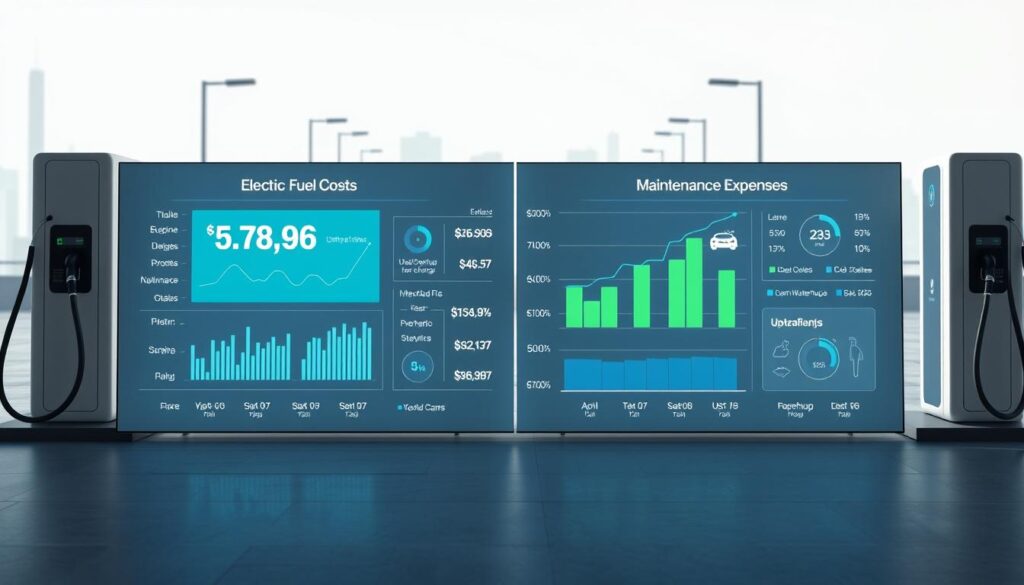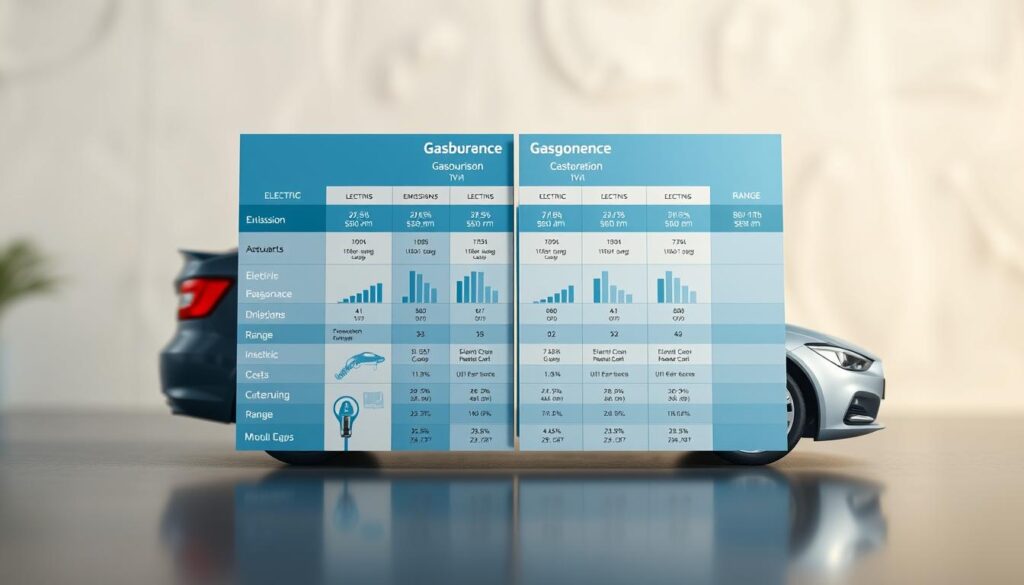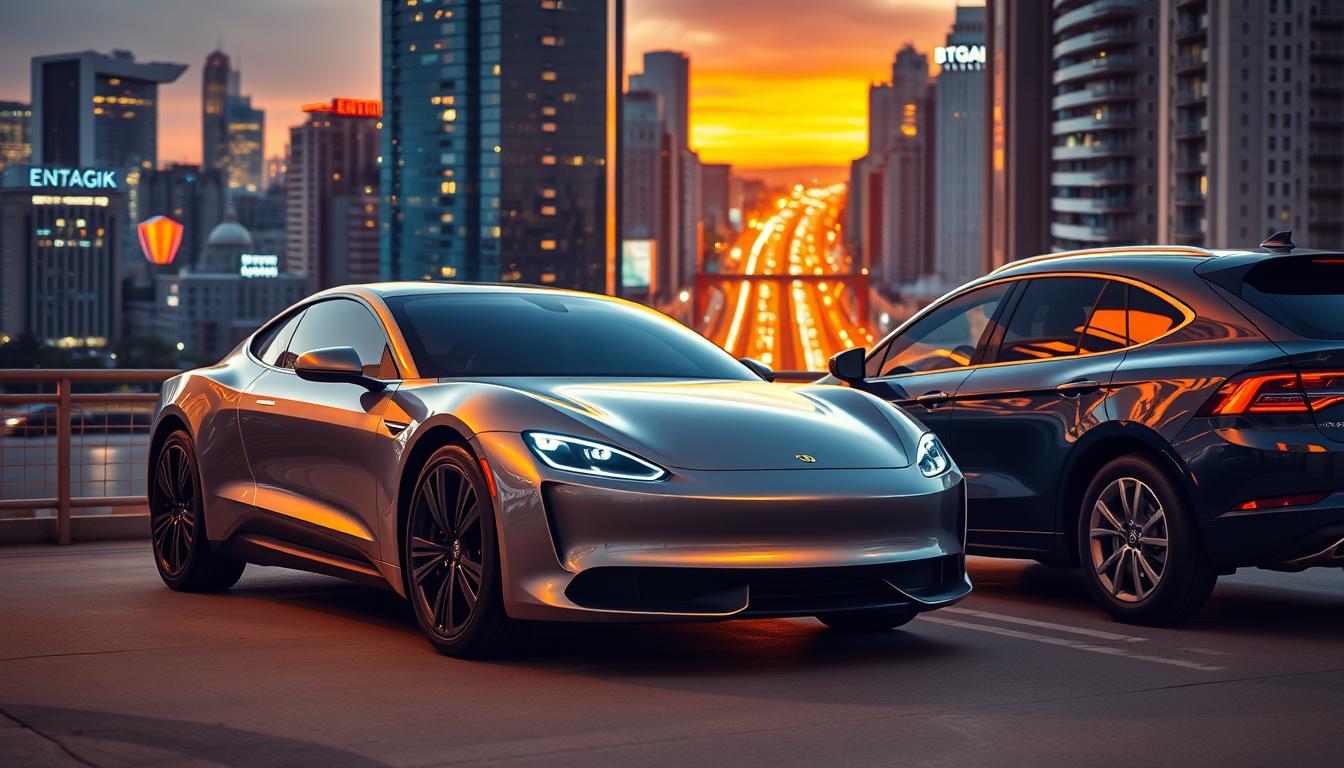Electric vs. Gasoline Cars: Which is Right for You?
Did you know transportation creates 29% of U.S. greenhouse gas emissions—more than any other sector? This startling fact highlights why choosing between modern vehicle options matters now more than ever. With automakers releasing new models yearly and governments pushing cleaner tech, drivers face a complex decision that goes far beyond fuel types.
Today’s buyers must weigh factors like upfront pricing, maintenance needs, and environmental impact. While gas-powered vehicles dominate roads, alternatives are gaining traction rapidly. The average American household spends nearly $3,000 annually on gas alone—a cost that could shrink dramatically with different choices.
This guide cuts through the noise. We’ll compare real-world expenses, ownership experiences, and eco-footprints without industry jargon. You’ll learn how charging networks compare to gas stations, why battery ranges have improved, and which option suits urban commutes versus road trips.
Key Takeaways
- Transportation choices directly impact both budgets and environmental health
- Total ownership costs include hidden expenses beyond sticker prices
- Charging accessibility continues expanding across the U.S.
- New incentives make cleaner options increasingly affordable
- Performance varies significantly between vehicle categories
- Personal driving habits determine ideal powertrain choices
Upfront Costs and Available Incentives
When budgeting for your next ride, sticker prices tell only part of the story. Modern buyers need to consider both immediate expenses and money-saving opportunities that could reshape their calculations.
Breaking Down Purchase Prices
New models with plugs currently average $5,804 more than gas-powered alternatives. But here’s the twist—that gap shrinks fast when incentives kick in. Take the Chevrolet Equinox EV: its $41,100 price drops to $33,600 after federal tax credits. Even entry-level options like Hyundai’s $32,875 Kona Electric become gas-car rivals after discounts.
Navigating Incentive Programs
Since January 2024, buyers can claim up to $7,500 instantly at dealerships instead of waiting for tax refunds. Income limits apply, but partial credits often remain available. Don’t stop at federal help—most states sweeten the deal further.
California offers $2,000 rebates, while Colorado provides $5,000. Utility companies frequently chip in with charging station discounts or special off-peak rates. Check your ZIP code in the Laws and Incentives database—you might uncover hidden savings that make your decision easier.
Fuel Costs, Charging Options, and Maintenance Overview

Your driving budget gets reshaped by three critical factors: where you power up, how often you visit mechanics, and what hides beneath the hood. Let’s break down the numbers that matter most.
Comparing Charging Costs and Public Infrastructure
Home charging slashes energy expenses dramatically. At $0.12-$0.24 per kWh, a full battery costs less than most movie tickets. Over a year, this adds up to $500-$800 – about what many families spend monthly on groceries.
Public stations charge more ($0.30+/kWh), but availability keeps improving. Drivers now find 162,000 charging ports nationwide – enough to circle the Earth twice if lined up. Time-of-use rates from utilities can cut nighttime charging costs by 50% in some states.
| Factor | EVs | Gas Vehicles | Annual Savings |
|---|---|---|---|
| Home Energy Cost | $600 | $2,100 | $1,500 |
| Public Fuel Cost | $900 | $2,200 | $1,300 |
| Routine Maintenance | $949 | $1,279 | $330 |
| Lifetime Repairs | $4,600 | $9,200 | $4,600 |
Maintenance Differences: EVs Versus Gas Vehicles
Fewer moving parts mean fewer repair bills. Without oil changes or spark plug replacements, EV owners save 31% annually on upkeep. Regenerative braking systems extend brake pad life by 50% compared to traditional vehicles.
While both vehicle types need tire rotations, gas models require 3x more fluid changes. Mechanics often find combustion engines need 12+ service items that electric motors simply eliminate. Over a decade, these savings could fund a family vacation.
Electric vs. Gasoline Cars: Comprehensive Comparison

Modern drivers often overlook a critical factor in vehicle selection: how efficiently machines convert energy into motion. This hidden metric separates leaders from laggards in today’s auto market.
Energy Efficiency and Performance Metrics
Today’s advanced models achieve what seemed impossible a decade ago. The average EV operates 2.6–4.8× more efficiently than gas counterparts, needing just 25–40 kWh to travel 100 miles. That’s like powering your home AC for two days versus filling a sedan’s tank.
Hybrids bridge old and new tech effectively. The Toyota Corolla Hybrid delivers 50 MPG combined—43% better than its gas-only sibling. Instant torque gives electric models an edge, with many reaching 60 mph 2–3 seconds faster than similar combustion vehicles.
Range Capabilities and Acceleration Insights
Distance anxiety fades as battery tech improves. Most new EVs offer 200–300+ miles per charge, though hills and headwinds affect results. Cold weather can trim ranges by 20%, while regenerative braking adds miles in city traffic.
| Model | MPG/MPGe | kWh per 100mi | 0–60 mph |
|---|---|---|---|
| 2024 Gas Sedan | 35 | N/A | 7.9s |
| Toyota Hybrid | 50 | N/A | 8.2s |
| EV Base Model | 130 | 28 | 5.8s |
Performance differences stem from engineering. Electric motors deliver maximum torque instantly, while combustion engines need revs to build power. This explains why many drivers describe EVs as “effortlessly responsive” compared to traditional options.
Environmental Impact and Long-Term Benefits

What if your daily commute could clean the air instead of polluting it? Modern vehicles now offer solutions that benefit both drivers and communities. Let’s explore how cleaner tech reshapes our environment and strengthens national resources.
Emissions, Carbon Footprint, and Public Health
Zero-exhaust vehicles eliminate harmful pollutants where people live and work. Urban areas see 60% fewer respiratory issues near EV adoption zones, according to recent studies. A Reuters analysis showed battery-powered models outperform gas equivalents environmentally within 13,500 miles—about a year’s driving for most Americans.
Your local power mix matters. Charging with solar or wind energy slashes lifetime emissions by 68% compared to coal-dependent regions. Even using average U.S. electricity, these vehicles produce half the carbon of gas models over 15 years.
Energy Security and Resilient Transportation
Every kilowatt-hour from diverse sources weakens oil dependence. With 70% less petroleum use per mile, battery-powered options protect against fuel price spikes. Modern energy storage units come with 8-year warranties—many outlast their vehicles.
Consider these advantages:
- Power grids use 40% renewable sources nationwide
- Recycled batteries now provide home energy storage
- Lifetime savings average $9,000 versus gas alternatives
As charging networks expand, drivers gain freedom from volatile gas prices. This shift creates a transportation system less vulnerable to global oil markets—a win for wallets and national stability.
Conclusion
Choosing your next ride comes down to three essentials: how you drive, where you live, and what you value long-term. For drivers clocking 15,000 miles yearly, plug-in models could save $1,000+ annually on fuel—enough to fund a weekend getaway. Urban commuters with home charging access often find these options ideal.
Yet traditional gas-powered models still shine in specific scenarios. Rural residents or budget-focused buyers might prefer their wider refueling options and lower upfront costs. Remember, your local electricity rates heavily influence savings—some states cut energy bills by 50% during off-peak hours.
Smart shoppers use tools like the EPA’s Fuel Economy Website to compare 7-year ownership costs. Maintenance averages $330 yearly for modern EVs—about what many spend on streaming services. Batteries now outlast most loans, with warranties covering 8-10 years.
Ultimately, your perfect match exists. Whether prioritizing $11,000 lifetime savings or immediate affordability, today’s market offers solutions for every roadmap. Test drive both types, crunch your numbers, and let your lifestyle steer the decision.
FAQ
Do federal tax credits apply to all electric cars?
How do charging costs compare to gasoline prices?
Are public charging stations easy to find?
Do EVs require less maintenance than gas vehicles?
Do federal tax credits apply to all electric cars?
How do charging costs compare to gasoline prices?
Are public charging stations easy to find?
Do EVs require less maintenance than gas vehicles?
FAQ
Do federal tax credits apply to all electric cars?
Not all models qualify. The IRS offers up to ,500 for new EVs meeting battery and assembly requirements. Brands like Tesla, Ford, and Chevrolet currently qualify, but incentives phase out once manufacturers hit sales thresholds. Check the IRS website for updated eligibility.
How do charging costs compare to gasoline prices?
Charging an EV typically costs 30–70% less per mile than fueling a gas car. For example, driving a Nissan Leaf 100 miles costs roughly .60 in electricity (national average), while a Toyota Corolla needs + in gas. Rates vary by state and utility plans.
Are public charging stations easy to find?
Yes, but availability depends on location. The U.S. has over 64,000 public charging ports, with networks like Electrify America expanding rapidly. Apps like PlugShare help locate stations, though rural areas still lag behind urban hubs.
Do EVs require less maintenance than gas vehicles?
Absolutely. With no oil changes, spark plugs, or complex transmissions, EVs have 50% fewer moving parts. Brake pads last longer due to regenerative braking. Maintenance costs average
FAQ
Do federal tax credits apply to all electric cars?
Not all models qualify. The IRS offers up to $7,500 for new EVs meeting battery and assembly requirements. Brands like Tesla, Ford, and Chevrolet currently qualify, but incentives phase out once manufacturers hit sales thresholds. Check the IRS website for updated eligibility.
How do charging costs compare to gasoline prices?
Charging an EV typically costs 30–70% less per mile than fueling a gas car. For example, driving a Nissan Leaf 100 miles costs roughly $3.60 in electricity (national average), while a Toyota Corolla needs $12+ in gas. Rates vary by state and utility plans.
Are public charging stations easy to find?
Yes, but availability depends on location. The U.S. has over 64,000 public charging ports, with networks like Electrify America expanding rapidly. Apps like PlugShare help locate stations, though rural areas still lag behind urban hubs.
Do EVs require less maintenance than gas vehicles?
Absolutely. With no oil changes, spark plugs, or complex transmissions, EVs have 50% fewer moving parts. Brake pads last longer due to regenerative braking. Maintenance costs average $0.06 per mile versus $0.10 for gas cars.
How does cold weather affect EV range?
Batteries lose 10–30% efficiency in freezing temps. Models like the Tesla Model Y or Ford F-150 Lightning use heat pumps to minimize loss. Preconditioning the battery while plugged in helps maintain range during winter drives.
Are electric cars truly better for the environment?
Yes, even with grid emissions. EVs produce zero tailpipe pollution and have a smaller lifetime carbon footprint. A study by the Union of Concerned Scientists found they emit 50% less CO2 than gas cars over their lifespan.
Can I install a home charger without major upgrades?
Most homes with 200-amp service can add a Level 2 charger. Costs range from $500–$2,000, including installation. Some utilities offer rebates, and the federal tax credit covers 30% of costs (up to $1,000) through 2032.
FAQ
Do federal tax credits apply to all electric cars?
Not all models qualify. The IRS offers up to ,500 for new EVs meeting battery and assembly requirements. Brands like Tesla, Ford, and Chevrolet currently qualify, but incentives phase out once manufacturers hit sales thresholds. Check the IRS website for updated eligibility.
How do charging costs compare to gasoline prices?
Charging an EV typically costs 30–70% less per mile than fueling a gas car. For example, driving a Nissan Leaf 100 miles costs roughly .60 in electricity (national average), while a Toyota Corolla needs + in gas. Rates vary by state and utility plans.
Are public charging stations easy to find?
Yes, but availability depends on location. The U.S. has over 64,000 public charging ports, with networks like Electrify America expanding rapidly. Apps like PlugShare help locate stations, though rural areas still lag behind urban hubs.
Do EVs require less maintenance than gas vehicles?
Absolutely. With no oil changes, spark plugs, or complex transmissions, EVs have 50% fewer moving parts. Brake pads last longer due to regenerative braking. Maintenance costs average
FAQ
Do federal tax credits apply to all electric cars?
Not all models qualify. The IRS offers up to $7,500 for new EVs meeting battery and assembly requirements. Brands like Tesla, Ford, and Chevrolet currently qualify, but incentives phase out once manufacturers hit sales thresholds. Check the IRS website for updated eligibility.
How do charging costs compare to gasoline prices?
Charging an EV typically costs 30–70% less per mile than fueling a gas car. For example, driving a Nissan Leaf 100 miles costs roughly $3.60 in electricity (national average), while a Toyota Corolla needs $12+ in gas. Rates vary by state and utility plans.
Are public charging stations easy to find?
Yes, but availability depends on location. The U.S. has over 64,000 public charging ports, with networks like Electrify America expanding rapidly. Apps like PlugShare help locate stations, though rural areas still lag behind urban hubs.
Do EVs require less maintenance than gas vehicles?
Absolutely. With no oil changes, spark plugs, or complex transmissions, EVs have 50% fewer moving parts. Brake pads last longer due to regenerative braking. Maintenance costs average $0.06 per mile versus $0.10 for gas cars.
How does cold weather affect EV range?
Batteries lose 10–30% efficiency in freezing temps. Models like the Tesla Model Y or Ford F-150 Lightning use heat pumps to minimize loss. Preconditioning the battery while plugged in helps maintain range during winter drives.
Are electric cars truly better for the environment?
Yes, even with grid emissions. EVs produce zero tailpipe pollution and have a smaller lifetime carbon footprint. A study by the Union of Concerned Scientists found they emit 50% less CO2 than gas cars over their lifespan.
Can I install a home charger without major upgrades?
Most homes with 200-amp service can add a Level 2 charger. Costs range from $500–$2,000, including installation. Some utilities offer rebates, and the federal tax credit covers 30% of costs (up to $1,000) through 2032.
How does cold weather affect EV range?
Are electric cars truly better for the environment?
Can I install a home charger without major upgrades?
FAQ
Do federal tax credits apply to all electric cars?
Not all models qualify. The IRS offers up to ,500 for new EVs meeting battery and assembly requirements. Brands like Tesla, Ford, and Chevrolet currently qualify, but incentives phase out once manufacturers hit sales thresholds. Check the IRS website for updated eligibility.
How do charging costs compare to gasoline prices?
Charging an EV typically costs 30–70% less per mile than fueling a gas car. For example, driving a Nissan Leaf 100 miles costs roughly .60 in electricity (national average), while a Toyota Corolla needs + in gas. Rates vary by state and utility plans.
Are public charging stations easy to find?
Yes, but availability depends on location. The U.S. has over 64,000 public charging ports, with networks like Electrify America expanding rapidly. Apps like PlugShare help locate stations, though rural areas still lag behind urban hubs.
Do EVs require less maintenance than gas vehicles?
Absolutely. With no oil changes, spark plugs, or complex transmissions, EVs have 50% fewer moving parts. Brake pads last longer due to regenerative braking. Maintenance costs average
FAQ
Do federal tax credits apply to all electric cars?
Not all models qualify. The IRS offers up to $7,500 for new EVs meeting battery and assembly requirements. Brands like Tesla, Ford, and Chevrolet currently qualify, but incentives phase out once manufacturers hit sales thresholds. Check the IRS website for updated eligibility.
How do charging costs compare to gasoline prices?
Charging an EV typically costs 30–70% less per mile than fueling a gas car. For example, driving a Nissan Leaf 100 miles costs roughly $3.60 in electricity (national average), while a Toyota Corolla needs $12+ in gas. Rates vary by state and utility plans.
Are public charging stations easy to find?
Yes, but availability depends on location. The U.S. has over 64,000 public charging ports, with networks like Electrify America expanding rapidly. Apps like PlugShare help locate stations, though rural areas still lag behind urban hubs.
Do EVs require less maintenance than gas vehicles?
Absolutely. With no oil changes, spark plugs, or complex transmissions, EVs have 50% fewer moving parts. Brake pads last longer due to regenerative braking. Maintenance costs average $0.06 per mile versus $0.10 for gas cars.
How does cold weather affect EV range?
Batteries lose 10–30% efficiency in freezing temps. Models like the Tesla Model Y or Ford F-150 Lightning use heat pumps to minimize loss. Preconditioning the battery while plugged in helps maintain range during winter drives.
Are electric cars truly better for the environment?
Yes, even with grid emissions. EVs produce zero tailpipe pollution and have a smaller lifetime carbon footprint. A study by the Union of Concerned Scientists found they emit 50% less CO2 than gas cars over their lifespan.
Can I install a home charger without major upgrades?
Most homes with 200-amp service can add a Level 2 charger. Costs range from $500–$2,000, including installation. Some utilities offer rebates, and the federal tax credit covers 30% of costs (up to $1,000) through 2032.
.06 per mile versus
FAQ
Do federal tax credits apply to all electric cars?
Not all models qualify. The IRS offers up to $7,500 for new EVs meeting battery and assembly requirements. Brands like Tesla, Ford, and Chevrolet currently qualify, but incentives phase out once manufacturers hit sales thresholds. Check the IRS website for updated eligibility.
How do charging costs compare to gasoline prices?
Charging an EV typically costs 30–70% less per mile than fueling a gas car. For example, driving a Nissan Leaf 100 miles costs roughly $3.60 in electricity (national average), while a Toyota Corolla needs $12+ in gas. Rates vary by state and utility plans.
Are public charging stations easy to find?
Yes, but availability depends on location. The U.S. has over 64,000 public charging ports, with networks like Electrify America expanding rapidly. Apps like PlugShare help locate stations, though rural areas still lag behind urban hubs.
Do EVs require less maintenance than gas vehicles?
Absolutely. With no oil changes, spark plugs, or complex transmissions, EVs have 50% fewer moving parts. Brake pads last longer due to regenerative braking. Maintenance costs average $0.06 per mile versus $0.10 for gas cars.
How does cold weather affect EV range?
Batteries lose 10–30% efficiency in freezing temps. Models like the Tesla Model Y or Ford F-150 Lightning use heat pumps to minimize loss. Preconditioning the battery while plugged in helps maintain range during winter drives.
Are electric cars truly better for the environment?
Yes, even with grid emissions. EVs produce zero tailpipe pollution and have a smaller lifetime carbon footprint. A study by the Union of Concerned Scientists found they emit 50% less CO2 than gas cars over their lifespan.
Can I install a home charger without major upgrades?
Most homes with 200-amp service can add a Level 2 charger. Costs range from $500–$2,000, including installation. Some utilities offer rebates, and the federal tax credit covers 30% of costs (up to $1,000) through 2032.
.10 for gas cars.
How does cold weather affect EV range?
Batteries lose 10–30% efficiency in freezing temps. Models like the Tesla Model Y or Ford F-150 Lightning use heat pumps to minimize loss. Preconditioning the battery while plugged in helps maintain range during winter drives.
Are electric cars truly better for the environment?
Yes, even with grid emissions. EVs produce zero tailpipe pollution and have a smaller lifetime carbon footprint. A study by the Union of Concerned Scientists found they emit 50% less CO2 than gas cars over their lifespan.
Can I install a home charger without major upgrades?
Most homes with 200-amp service can add a Level 2 charger. Costs range from 0–,000, including installation. Some utilities offer rebates, and the federal tax credit covers 30% of costs (up to
FAQ
Do federal tax credits apply to all electric cars?
Not all models qualify. The IRS offers up to $7,500 for new EVs meeting battery and assembly requirements. Brands like Tesla, Ford, and Chevrolet currently qualify, but incentives phase out once manufacturers hit sales thresholds. Check the IRS website for updated eligibility.
How do charging costs compare to gasoline prices?
Charging an EV typically costs 30–70% less per mile than fueling a gas car. For example, driving a Nissan Leaf 100 miles costs roughly $3.60 in electricity (national average), while a Toyota Corolla needs $12+ in gas. Rates vary by state and utility plans.
Are public charging stations easy to find?
Yes, but availability depends on location. The U.S. has over 64,000 public charging ports, with networks like Electrify America expanding rapidly. Apps like PlugShare help locate stations, though rural areas still lag behind urban hubs.
Do EVs require less maintenance than gas vehicles?
Absolutely. With no oil changes, spark plugs, or complex transmissions, EVs have 50% fewer moving parts. Brake pads last longer due to regenerative braking. Maintenance costs average $0.06 per mile versus $0.10 for gas cars.
How does cold weather affect EV range?
Batteries lose 10–30% efficiency in freezing temps. Models like the Tesla Model Y or Ford F-150 Lightning use heat pumps to minimize loss. Preconditioning the battery while plugged in helps maintain range during winter drives.
Are electric cars truly better for the environment?
Yes, even with grid emissions. EVs produce zero tailpipe pollution and have a smaller lifetime carbon footprint. A study by the Union of Concerned Scientists found they emit 50% less CO2 than gas cars over their lifespan.
Can I install a home charger without major upgrades?
Most homes with 200-amp service can add a Level 2 charger. Costs range from $500–$2,000, including installation. Some utilities offer rebates, and the federal tax credit covers 30% of costs (up to $1,000) through 2032.
,000) through 2032.

Adam Peter is a finance, travel, and automotive writer with over a decade of experience. He creates clear, practical content to help readers manage their money, explore the world with confidence, and make informed decisions about cars and travel gear. His work blends expert insight with real-world usefulness.




